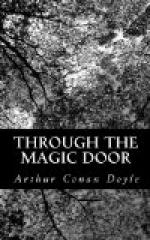In his visit to Paris Scott must have seen many of those iron men who during the preceding twenty years had been the scourge and also the redemption of Europe. To us the soldiers who scowled at him from the sidewalks in 1814 would have been as interesting and as much romantic figures of the past as the mail-clad knights or ruffling cavaliers of his novels. A picture from the life of a Peninsular veteran, with his views upon the Duke, would be as striking as Dugald Dalgetty from the German wars. But then no man ever does realize the true interest of the age in which he happens to live. All sense of proportion is lost, and the little thing hard-by obscures the great thing at a distance. It is easy in the dark to confuse the fire-fly and the star. Fancy, for example, the Old Masters seeking their subjects in inn parlours, or St. Sebastians, while Columbus was discovering America before their very faces.
I have said that I think “Ivanhoe” the best of Scott’s novels. I suppose most people would subscribe to that. But how about the second best? It speaks well for their general average that there is hardly one among them which might not find some admirers who would vote it to a place of honour. To the Scottish-born man those novels which deal with Scottish life and character have a quality of raciness which gives them a place apart. There is a rich humour of the soil in such books as “Old Mortality,” “The Antiquary,” and “Rob Roy,” which puts them in a different class from the others. His old Scottish women are, next to his soldiers, the best series of types that he has drawn. At the same time it must be admitted that merit which is associated with dialect has such limitations that it can never take the same place as work which makes an equal appeal to all the world. On the whole, perhaps, “Quentin Durward,” on account of its wider interests, its strong character-drawing, and the European importance of the events and people described, would have my vote for the second place. It is the father of all those sword-and-cape novels which have formed so numerous an addition to the light literature of the last century. The pictures of Charles the Bold and of the unspeakable Louis are extraordinarily vivid. I can see those two deadly enemies watching the hounds chasing the herald, and clinging to each other in the convulsion of their cruel mirth, more clearly than most things which my eyes have actually rested upon.
The portrait of Louis with his astuteness, his cruelty, his superstition and his cowardice is followed closely from Comines, and is the more effective when set up against his bluff and war-like rival. It is not often that historical characters work out in their actual physique exactly as one would picture them to be, but in the High Church of Innsbruck I have seen effigies of Louis and Charles which might have walked from the very pages of Scott-Louis, thin, ascetic, varminty; and Charles with the head of a prize-fighter.




